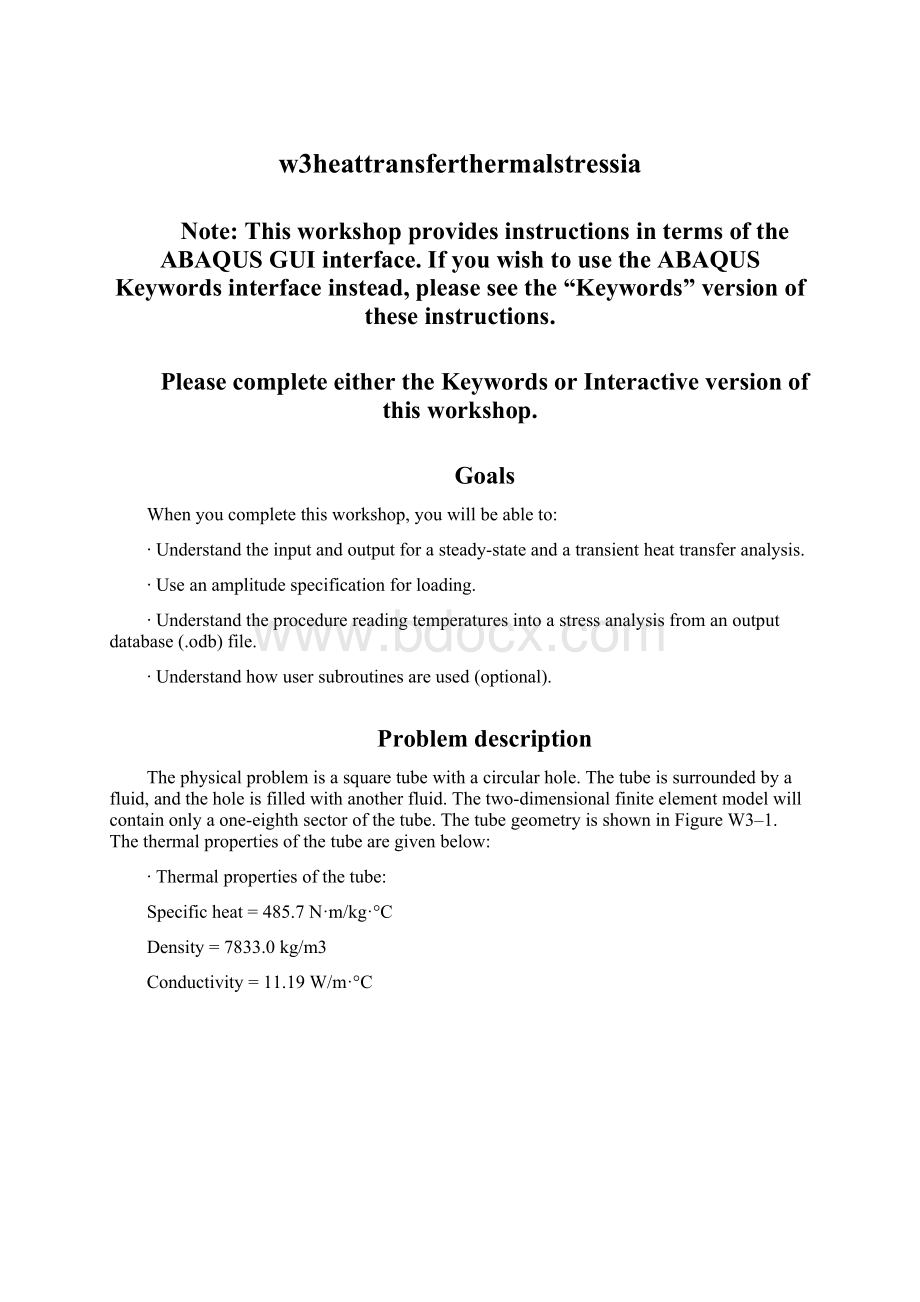w3heattransferthermalstressiaWord格式文档下载.docx
《w3heattransferthermalstressiaWord格式文档下载.docx》由会员分享,可在线阅读,更多相关《w3heattransferthermalstressiaWord格式文档下载.docx(10页珍藏版)》请在冰豆网上搜索。

∙Thermalpropertiesofthetube:
Specificheat=485.7N·
m/kg·
°
C
Density=7833.0kg/m3
Conductivity=11.19W/m·
FigureW3–1Squaretubewithcircularhole.
Preliminaries
1.Entertheworkingdirectoryforthisworkshop:
../heat_transfer/interactive/workshop3
2.Runthescriptws_ht_thermalStress.pyusingthefollowingcommand:
abaquscaestartup=ws_ht_thermalStress.py
TheabovecommandcreatesanABAQUS/CAEdatabasenamedthermalStress.caeinthecurrentdirectory.Themodelcontainsallthedatanecessarytorunasteady-stateheattransferanalysisofthetube.Youwillbeginthisworkshopbyrunningthissteady-stateheattransferanalysis.Later,youwillmodifythemodeltoperformadditionalthermalandstructuralanalysesofthetube.
Steady-stateheattransferanalysis
AppliedTemperatures
Wewillstartwithasteady-stateheattransferanalysisinwhichthefluidtemperaturesareapplieddirectlytothenodesoftheinnerandouterwallsofthetube.Thisapproachimpliesthatthefluidstouchingthewallsareinfiniteheatsinks.
3.Submitthejobnamedsteady_bctorunthemodelsteadyHeatTransfer.
4.Afterthejobcompletes,opensteady_bc.odbintheVisualizationmodule.Theundeformedmodelshapeisplottedbydefault.
5.UsetheResultsTreetodeterminethelocationsofthedifferentnodeandelementsets.
a.IntheResultsTree,expandtheElementSetsandNodeSetscontainersunderneaththeoutputdatabasenamedsteady_bc.odb.
b.Selectdifferentsets;
thecorrespondingsetswillbehighlightedintheviewport.
c.Onceyouarefamiliarwiththelocationsofthedifferentsets,collapsethecontainers.
Onlyone-eighthofthecross-sectionneedstobemodeledbecauseofsymmetry.
QuestionW3–1:
Whatshouldtheboundaryconditionsbeatthosesymmetrylines?
Whataretheappliedboundaryconditionsinthemodel?
Thinkaboutthedifferencebetweenenforcingsymmetryforathermalboundaryascomparedtothatforadisplacementboundary.
6.Createacontourplotofthetemperature(variableNT11).Theprocedureisprovidedbelow.Checkthecontourlinesatthesymmetrylines.Thecontourlinesshouldbenormaltotheedgeifthesymmetryconditionsarecorrectlyenforced.
d.Fromthemainmenubar,selectResultFieldOutput.
e.IntheFieldOutputdialogbox,selectNT11(nodaltemperature)astheprimaryvariable.ClickOK.
f.IntheSelectPlotStatedialogbox,chooseContourandclickOK.
Filmcoefficients(forsurfaceconvection)
Theinterfacebetweenthetubeandthefluidscanbemodeledmorerealisticallybydefiningfilmcoefficientsandsinktemperatures.
1.CopythemodelsteadyHeatTransfertoamodelnamedsteadyHeatTransfer-film.
a.IntheModelTree,clickmousebutton3onsteadyHeatTransferandselectCopyModelinthemenuthatappears.
b.EntersteadyHeatTransfer-filmasthenameofthenewmodel.
2.Inthenewmodel,removethetwoexistingboundaryconditionswhichsetthetemperatureoftheinnerandouterwalls.(Clickmousebutton3onthemintheModelTreeandchooseeitherDeleteorSuppress.)
3.Defineasurfacefilmconditionnamedholeonthesurfaceholewithafilmcoefficientof1500W/m2·
Candasinktemperatureof400°
C.
DetailsofthesurfacefilmconditiondefinitionprocedurearegiveninWorkshop2.
4.Defineasurfacefilmconditionnamedouteronthesurfaceouterwithafilmcoefficientof30
W/m2·
Candasinktemperatureof500°
C.
5.Createajobnamedsteady_filmforthemodelsteadyHeatTransfer-film.
6.Submitthejobforanalysis.Checkthejobmonitorforanymodelingerrorsandmakeanynecessarycorrections.
7.Afterthejobcompletes,opensteady_film.odbintheVisualizationmodule.
8.Createacontourplotoftemperature.Tocomparetheseresultstotheresultsintheappliedtemperaturemodel,youcandisplaybothcontourplotsatthesametimeasfollows:
a.Fromthemainmenubar,selectViewportCreate.
Thenewviewportappears.
b.Fromthemainmenubar,selectViewportTileVerticallytoarrangetheviewportssothatbothareclearlyvisible.
c.Inoneviewportopentheoutputdatabasefortheappliedtemperaturemodel,andintheotherviewportopentheoutputdatabaseforthesurfaceconvectionmodel.Createcontourplotsofthetemperature,andcomparethem.
QuestionW3–2:
Howdoestheplotforthemodelusingfilmconditionscomparetotheplotfortheappliedtemperaturemodel?
(Thinkabouthowthefilmconditionattributescouldbechangedsothattheresultswouldbethesameasfortheappliedtemperaturemodel.Thisprocessisanoptionalexerciseifyouhavetimeattheendoftheworkshop.)Howdotheresultsreflecttherelativemagnitudesofthefilmcoefficients?
9.Returntotheoriginalsingleviewport.
g.Toremoveoneoftheviewports,clickthedeletebuttoninthetoprightcorneroftheviewport.
h.Tomaximizetheremainingviewport,clickthemaximizebuttontotheleftofthedeletebutton.
Transientheattransferanalysis
Wewillnowmodelthecaseinwhichtheinnerandouterfluidsstartatthesametemperatureandthetemperatureoftheinnerfluidisrampeddownto400°
Cover10secondsandisthenheldconstantatthattemperature(seeFigureW3–2below).Thischangecanbespecifiedbyusinganamplitudecurve.
FigureW3–2Sinktemperaturevariationforsurfaceconvection.
CopythemodelsteadyHeatTransfer-filmtoamodelnamedtransientHeatTransfer.
Makethefollowingchangestotheheattransferstep(ModelTree:
Steps:
double-clickStep-1):
i.Modifythestepdescriptionto"
Transientheattransfer."
j.SetthestepresponsetypetoTransient.ABAQUS/CAEwillautomaticallychangethedefaultloadvariationto"
Instantaneous."
k.Changethesteptimeperiodto10000.
l.Setthemaximumnumberofincrementsto200.
m.Specifyaninitialincrementsizeof2.5.
n.Endthestepwhenthetemperaturechangerateislessthan0.001.
o.Setthemaximumallowabletemperaturechangeperincrementto10.
Thus,thisstepspecifiesatransientanalysisthatendswhensteadystateisreached(definedbythetemperaturechangerate).ABAQUSwilluseautomatictimeincrementationtokeepthemaximumtemperaturechangeatanynodeinanincrementunder10°
Createatabularamplitudecurvenamedtemp1withthedataprovidedinTableW3–1,sothattheamplitudemagnitudebeginsat500,rampsdownto400bytime10,andthenremainsconstant.
p.IntheModelTree,double-clickAmplitudes.
q.Nametheamplitudetemp1andacceptTabularastheamplitudetype.
r.EntertheamplitudedataprovidedinTableW3–1.
TableW3–1Amplitudedata.
Time
Amplitude
0.0
500.
10.0
400.
1000.0
Editthefilmconditionhole,sothattemp1isthesinktemperatureamplitude(ModelTree:
Interactions:
double-clickhole).Changethemagnitudeofthesinktemperatureto1.0(thisvaluewillbescaledbytheamplitudecurve).
Createatemperaturefieldintheinitialsteptoassignaninitialtemperatureof500tothesetplate.
7.CreateajobnamedtransientHeatforthemodeltransientHeatTransfer.Theresultsfromthisanalysiswillbeusedtodrivethesubsequentstressanalysis;
doubleprecisionoutputisdesirableinthiscase.Thus,setthenodaloutputprecisiontoFull.
8.Submitthejobforanalysisandmonitoritsprogress.
QuestionW3–3:
Whatdoyounoticeabouttheincrementsize?
Arethesizesofthelastincrementsreasonable?
9.OpentransientHeat.odbintheVisualizationmoduleandplottemperaturecontours.Comparethetemperaturesatvarioustimestothetemperaturesinthesteady-stateanalysis.
10.CreateX-Yplotsofthetemperaturevariationovertimeforafewdifferentnodes.Tryplottingtemperaturesforafewpointsalongthediagonalonthesameplot.
TherearetwowaystoobtaintheX-Ydataneededtocreatethesetemperatureplots.Onemethodistorequestthedataashistoryoutput,andreruntheanalysis.HistorydatamaybeusedtocreateX-Yplotsdirectly(ResultHistoryOutputintheVisualizationmodule).ThesecondmethodistoextracttheX-Ydatafromthefieldoutput.Thedetailsofthistechniquefollow:
s.IntheResultsTree,double-clickXYData.
t.IntheCreateXYDatadialogbox,selectODBfieldoutputasthedatasource.
u.IntheVariablestabbedpageoftheXYDatafromODBFieldOutputdialogbox,chooseUniqueNodalasthevariableposition.ToggleonNT11:
Nodaltemperature.
v.ClicktheElements/Nodestabandselectthenodesetforwhichyouwouldliketoextractnodaltemperatures.
w.ClickPlot.
Thermal-stressanalysis
Thesamegeometrycanbeusedforastressanalysis.Wewilldefineaprobleminwhichtheinitialloadingisauniformpressurizationappliedtotheinnerwallofthetube.
11.CopythemodeltransientHeatTransfertoamodelnamedstress.
12.Addthe